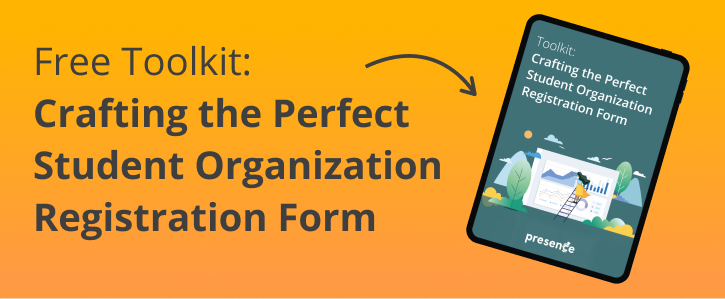Advising students who want to start a new organization can be as much work as advising an already-established org.
Drafting a constitution, recruiting interested students, and brainstorming event ideas are just some of the things that students need to do in order to register a new org. An interest group that can demonstrate a clear need for the organization and shows that they’ve thought through how to be self-sustaining has a good chance of earning approval.
If you find yourself with this type of responsibility, use these eight points to guide your discussions with students.
Mission
The organization’s mission, vision, and values should be discussed first to lay the foundation for all other conversations.
A mission statement is a concise statement of why an organization exists.
Before workshopping the final version of the mission statement, come up with a draft. The draft mission statement will be used to answer the essential question of “How is our organization different from existing groups on campus?”
Having students answer this question should prevent duplicate organizations from forming. When first asked about the purpose of their organization, many students will frame it in terms of the activities they want to host.
Consider the following example that illustrates how this framing is troublesome:
A debate club might claim that its mission is to “hold moderated debates and rhetoric workshops”. But how would that make them different from, say, the philosophy club, which also holds debates? If the debate club instead says that their mission is to “promote a society in which we can have controversy with civility,” then they’ll distinguish themselves from the philosophy club, whose mission is to promote knowledge and appreciation of philosophy.
The mission statement should inform the types of activities that organizations conduct, not vice versa. If students are unable to describe how their proposed organization is different from an existing one, then you should encourage collaboration with the other group, not the formation of a new one.
Vision
While a mission statement focuses on what an organization is doing in the present, a vision statement focuses on the group’s future.
“A vision statement is an aspirational statement about what an organization wants to achieve or be known for.”
When students bring you a draft of their vision statement, discuss how they envision the organization growing and changing to meet that vision over the next few years.
The purpose of this long-term exercise is to help students evaluate if their organization will be sustainable. Sometimes, students want to start an organization in reaction to current events, such as political organizations that are founded on campus right before a presidential election.
If students have identified an unmet need on campus but are having trouble visualizing the organization lasting beyond a few years, then you should help them identify ways to carry out a short-term project. They may be able to secure funding for a project from the SGA, academic departments, or a grant from the dean of students office.
Some examples of election season projects might include inviting local elected leaders to campus to talk about civics, running a voter registration drive, or hosting information sessions to explain local and state ballot measures.
Values
Articulating organizational values grounds future decision-making in a way that aligns with the mission and vision statements.
“Organizational values are the core ethics that the organization will abide by in every circumstance.”
Students may fall into a trap of trying to pick too many values for their organization. If everything is a core value, then nothing is a priority. A good rule of thumb is to have three-to-five organizational values.
The following exercise can help students narrow down what values are most important to them:
- Provide a list of values to each executive board member and ask them to individually pick the top ten values that they feel best represent the organization.
- Of those ten, the students will pick three-to-five to keep on their individual list.
- For the remaining values on the list, have students write down examples demonstrating how the organization would live out that value.
- Finally, have students share their final list and examples with each other. Students will decide as a group which values make the final cut and agree on a common definition for each.
Choosing an advisor
Even if your department doesn’t require student organizations to have an advisor, encourage students to discuss the possibility with one or two faculty or staff members anyway. An advisor can help student leaders with long-term planning and following through on their goals.
Before extending an invitation to a potential advisor or choosing between candidates, review with students the qualities that make a good advisor. Ask them:
- Would the potential advisor have time to attend the organization’s meetings and events?
- Is the potential advisor fully committed to fulfilling the role as advisor, not just signing paperwork?
- Can the potential advisor reasonably commit to the role for at least the next few years? Do they have plans to retire, change institutions, or take on a responsibility that would impact their ability to be an advisor?
- What knowledge, skills, or connections does the potential advisor have to benefit the organization?
- Will the potential advisor be good at holding executive members accountable in meeting goals?
Structuring Leadership
A successful organization is going to need an executive board that is the right size and has positions that correspond with the organization’s needs. Departmental policies usually require a minimum of a president, vice president, secretary, and treasurer.
Overenthusiastic students may pack their board with as many positions as possible; it’s your job to help them decide if any positions are redundant and if it’ll be feasible to fill all of those positions during their next election.
Beyond the four positions listed above, here are some examples of additional leadership roles:
- Business manager: This position combines the role of secretary and treasurer into one.
- Events coordinator: If the organization only plans a few events a semester, this position can streamline the planning process. The event coordinator doesn’t have to plan all of the events; they can chair committees that’ll help with that.
- Marketing/social media coordinator: Social media marketing is complex; a position dedicated to routinely posting content and engaging with commenters acknowledges the importance of online interactions in recruitment and engagement.
- Community liaison/outreach coordinator: This position can serve as a primary contact for forming and maintaining crucial relationships with organizations and individuals outside of the institution
- Risk manager: Risk management isn’t just for Greek life. Any organization that plans large social events (such as parties, galas, dances) or off-campus trips may benefit from having a dedicated person who is trained on mitigating safety risks. Just remember: this position shouldn’t replace holding thorough pre-event reviews with a professional staff member.
- Alumni liaison: Getting alumni involved can enrich the student organization’s programming. Alumni of particular academic majors may be interested in hosting industry-specific skill-building workshops and attending networking events with students. Alumni who share an identity with affinity-based groups may want to stay connected through mentoring programs and community celebrations.
- Diversity & inclusion coordinator: Although DEI is something that all executive board members should commit themselves to, a dedicated DEI coordinator can exclusively focus on how to create an inclusive organizational culture. Their responsibilities could include reviewing whether membership requirements (such as time commitments and financial costs) could be preventing some students from participating or if guest speakers represent the range of identities that students hold.
- Member-at-large: This type of position does not have any specific duties on the executive board, hence the member-at-large can take on projects or serve on committees as needed. If the inaugural executive board is chosen from the members of the interest group before the first general member meeting, an at-large member could be elected by the new members at the first or second meeting.
Recruiting interest
Besides finding students to serve on the inaugural executive board, the organization will also need to demonstrate that there is significant interest from students who want to be involved as general members. The minimum number of signatures to collect (excluding executive board members) can range from five to 15, depending on the institution.
Encourage the executive board to collect signatures from students who represent a mix of different class years. Having too many rising-seniors in the initial group means that there will be an exodus of members when they graduate. You’ll also want to double-check that there are no graduating seniors on the signature list.
One way that students can recruit potential members is to table in a high-traffic area. Help students craft a marketing pitch that will entice potential members to sign up for the interest group. Students can view some example pitches and other recruitment strategies here.
Another idea is to host an informational night. This could involve a board game competition, video game tournament, or something else that utilizes resources that are readily available to students through the student activities office. Virtual game nights using a webinar platform or Brightful is another option.
Whichever format they use, students should leave time to introduce the executive board and talk about why potential members should join the interest group.
If the group is major-specific or a chapter of a national organization, then an academic department or the national organization should be able to provide recruitment resources.
Setting up a calendar
To engage general members, the executive board must have a plan in place for how they’ll structure meetings.
New student leaders tend to think of general meetings as a time to give updates and plan events. While that’s true, there is potential to structure the meeting in a way that clearly helps fulfill the organization’s mission.
For clubs that are organized around a hobby or niche interest, meetings could include the opportunity to use tools and space to partake in the hobby, or a workshop given to members by a volunteer expert. If the club is major-specific, meetings could be turned into opportunities to network with professionals. For identity-based organizations, the gathering of members could be less of a meeting and more of a safe space to share stories and build community.
Varying the meeting structure and content will help with member retention efforts by amping up students’ FOMO (Fears of Missing Out). Restricting sought-after programming — such as exclusive workshops and networking opportunities — to only members can also be a huge recruitment talking point.
Next up, students will need to decide how often they want to hold campus-wide events and the nature of these events. Keep in mind that new student organizations start off with smaller budgets, so students should focus on identifying a few high-visibility events in line with their mission.
Applying for Recognition
After all of the conversations that you have with students about their proposed organization, they should have everything that they need to either present before your institution’s student organization recognition committee or fill out the new organization application.

If you have the time, invite students to show you a practice run of their presentation. Consider asking them some of the questions that are listed below to help them prepare for the committee’s inquiries.
- What makes your proposed organization unique from existing ones?
- How will your proposed organization benefit the campus community?
- How do you know that there will be enough demand in the future for your proposed organization to continue to have the minimum number of members?
- What types of activities does your proposed organization want to plan?
- Why did you structure your executive board this way?
When students’ enthusiasm is combined with your guidance, their dream of founding a new organization can become a reality. It will certainly be a lot of work now but think of the hundreds of students who will benefit from this organization in the near future.
How have you helped empower students throughout the org registration process? Connect with us on Twitter @themoderncampus and @JustinTerlisner.





